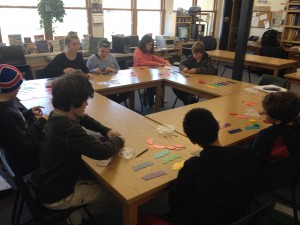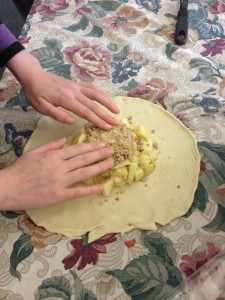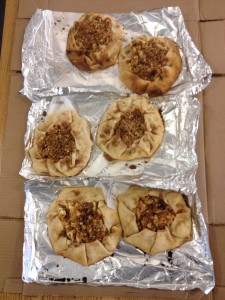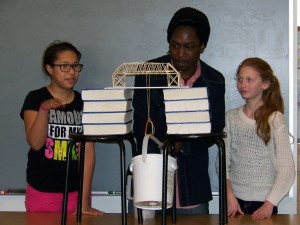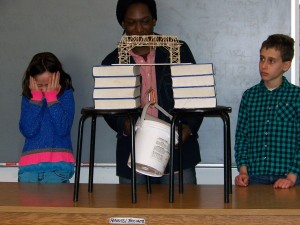April, May, and part of June . . . that’s it. So what are we going to do in that time?
First, we will be setting up the new small math binders so that students will be taking home some finished work as well as new assignments. That and some other changes we will be making should make our students’ homework in math easier to accomplish. At the same time, we want to say yet again that homework is not intended to be completed with total accuracy by every student. It’s a continuous assessment and planning tool — it shows us what needs review and more explanation, what is secure, and what new challenges are appropriate. Parents are welcome to help, but we really want to know what your child knows and is ready to do on the next day.
This is the time of year in which we do our “Changes and Choices” curriculum. As your child moves into adolescence (on many different timetables), there are body changes and social changes. In middle school, s/he will meet many new people whose experiences and interests are likely to come from a wider world than the one Miquon has offered. In addition, s/he will be sharing space and perhaps classes with students who are older. In addition to all of this opportunity for positive growth, we have the dreaded trinity of Sex, Drugs, and Risky Behavior. So we look for ways to prepare our kids to make good choices.
The emphasis is on independent choice. Our children need to be given information and a clear awareness of being in control. But there are potentially opposing pressures. They will want to be accepted socially in their new school. They may hear confident statements from new friends that fall into the “everyone else is doing it” category — whether it’s about drugs,tobacco, alcohol, plagiarism, misuse of social media, and countless other bad options. So we hope to help you support your children as strong and independent thinkers, enabling them to choose their friends on the basis of family values and common interests instead of perceived popularity or social power.
Our two major resources for this learning experience are a website (kidshealth.org) and a program (Our Whole Lives, or O.W.L.), and we have a large collection of print materials to add to those two primary resources. Healthy choice education includes sex and sexuality. This is probably the most emotionally-charged thing we do at school, one that overlaps strongly with family values and practices, so parents are always welcome to ask that their child be excluded from that part of our program. However, you should consider the likelihood that an excluded child will be getting information second-hand from classmates, and that may not be as accurate or as sensitively delivered as what happened in class. Please let us know if you do want your child to be given some free reading time in place of our discussions that focus on sex and sexuality. We can’t micromanage it further than that, as student questions will have a lot of influence on the direction of our meetings, and we never know what will come up.
We will be starting our third and final topic in social studies this coming week: the foundation beliefs and rise of Islam and the history of three medieval West African kingdoms. The two subtopics are both separate and connected. As Islam spread westward across the northern part of Africa, its proponents took two routes. One group went north across the Strait of Gibraltar to conquer Spain, which remained under Muslim rule for the next 700 years. As a result, Spain became a center of higher learning for its neighbors and a place of relative security for Jews (compared to their precarious position in Christian Europe). The other Muslim army turned south and met well-defended kingdoms with iron weapons, at which point plans for military conquest were abandoned in favor of establishing trade, especially for salt and gold. The universities and their libraries at Timbuktu, Goa, and Djenne were unrivaled, and the evolving blend of African and Arab culture was expressed in literature, architecture, mathematics, medicine, music, art, astronomy, and more. Many of the enslaved people brought to the New World were from the area successively known as the kingdoms of Ghana, Mali, and Songhai — bearers of this blended set of beliefs, knowledge, and traditions. To give our study of Islam a broader context, we will also be looking at other world religions, including Christianity, Judaism, Hinduism, and Buddhism.
In May, we’ll start preparation for graduation. In class, students will be working on writing their graduation speech, which is a very personal and reflective document. Parents will be asked for anecdotes that our fifth grade friends will turn into skits to be presented the night before the big ceremony. Kids will argue endlessly with each other and Diego about graduation music. At home, they will be doing one more project — the “Independent Project” that is somewhat similar to the recent Life Skills 101 activity but is much more open. What would you like to learn or do or ?? We’ll send home more information about that near the end of April.
There is more, of course — wrapping up the genre and author studies, embarking on new topics in math, creating and/or selecting writing for publication in Miquon Grass, enjoying another field trip or two, camping out one more time in the woods near my house — and suddenly they’ll be standing in their best clothes on a June day with diplomas in hand, wondering how it went by so fast.
Still, we have some 2 and 1/2 months of school to go (doesn’t that sound longer than 10 weeks?) and we’ll make the most of them.


